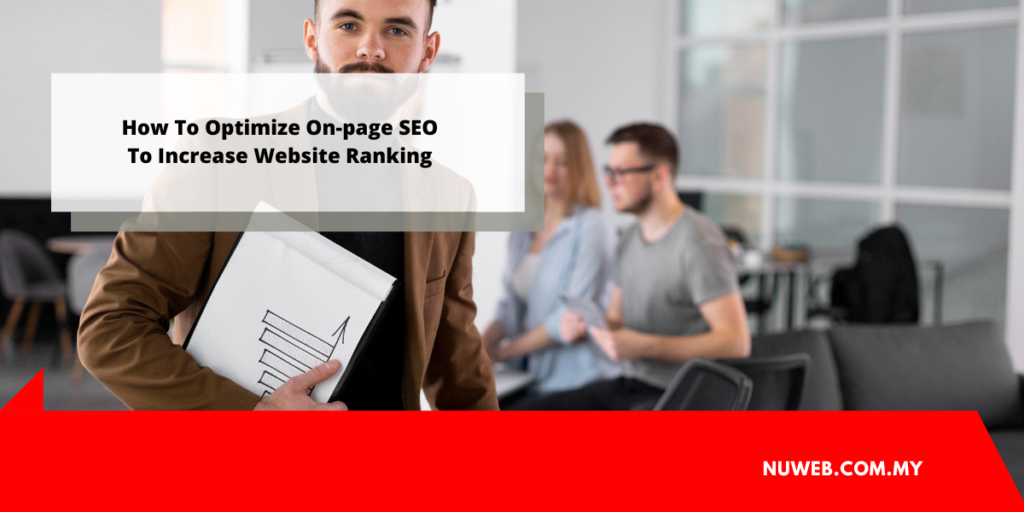10 Dec How To Optimize On-page SEO To Increase Website Ranking
How to write SEO articles that Google likes
The application of search engine optimization (SEO) is an effective marketing method in reaching potential customers, especially when considering that many people are used to searching online before buying. As many as 85 percent of people do a Google search before transacting online, while 81 percent also do a similar search when they are about to make a purchase at a brick-and-mortar store.
In the practice of search engine optimization, there are on-page and off-page SEO strategies, where on-page refers to aspects within website pages, while off-page relates to technicalities outside the website. This article will discuss how to optimize on page SEO so you can get a high ranking in Google’s page ranking. Come on, see more below!
How to optimize on page SEO to increase website ranking
On page SEO is a strategy to optimize content along with technical aspects on website pages. Through on-page SEO, your site can increase the chances of getting a high page ranking on Google. Here’s a list of ways to get more and more website visitors.
Before discussing other techniques, please note that content quality still holds the most important position. This is because search engine algorithms will sort content based on its ability to solve problems or answer user questions. So, first get to know the target audience so you can find out their problems.
The title of the article is an important component in how to optimize on page SEO. So that website pages can reach the top rankings, make sure the title matches the content. Avoid bombastic titles just for clickbait because your page will be judged to be of low quality.
Ever heard of the term permalink? Permalink stands for permanent link, which is the URL for each uploaded website. The goal is for website pages to have their respective access addresses. In addition, permalinks also make it easier for Google’s algorithm to sort sites. So, usually the permalink also contains the article keywords.
In on-page SEO optimization, of course keywords or keywords are one of the elements that are prioritized. This is because search engine users must enter keywords to find answers to their problems. Keywords also play a role in achieving top Google page rankings. However, don’t let the placement of keywords be too pushy. Remember that articles are written to be read by humans, not just to fulfill SEO technicalities.
Written uploads can be accompanied by appropriate supporting images. For example, an article page on healthy diet tips can be equipped with photos of healthy foods or a diet menu schedule. Images can improve website performance, because they make your website discoverable through image and text searches. Readers can more easily understand the contents of the article with visualization support.
Even so, make sure the supporting images can indeed be used for websites or other media. Images like this usually have a creative commons license. If you want to allocate a budget to get better images, visuals can also be obtained through subscriptions to paid image providers, such as Shutterstock.
How to optimize on page SEO is not only related to aspects of writing, but also the loading speed of the website. If the website takes a long time to load, it is likely that users will look for other alternatives to solve the problem. Search engine algorithms are also aware of this, so websites with low speed will automatically get a lower Google page ranking as well.
Apart from written content, adding visual content such as images and videos can also help optimize your on-page SEO. Of course you can’t just put pictures or videos, there are a few things to note.
First, make sure the image size is not too large, preferably not exceeding 100 kb so that your website is not “heavy” when loading. Then, use the main keyword as the file name of the image. The goal is to help visual content appear in Google Images search results.
No less important, you also need to change the alternative text or alt text according to the main keywords. Having alt text will make it easier for Google to identify the content topics you discuss, while increasing the chances of images appearing in search results.
Internal links are links that refer to other content pages on your website. With notes, the content that is the purpose of internal links is also still relevant or related to the content that visitors are reading. Providing internal links can make visitors stay longer on your website.
Meanwhile, an outbound link is also a link, but it refers to other content outside your website that serves as a reference. Having outbound links can make your content more credible and trusted.
Actually, there is no set rule for how many words you should write on website content. This usually depends on the keywords you are targeting. For keyword X, content may only need 700 words, while content for keyword Y may need up to 2500 words.
As another benchmark, you can also check competitor content. Take a look at the content that appears in the top three rankings of search results. So, from there you can create content with a similar number of words or more than your competitors.
In this case, the meaning of a responsive theme is a website theme that is compatible with any device. So, when accessed via desktop, mobile or tablet devices, your website will still appear and run responsively and smoothly. That way, visitors always feel it.
For more information about , please visit
This content was originally published here.




